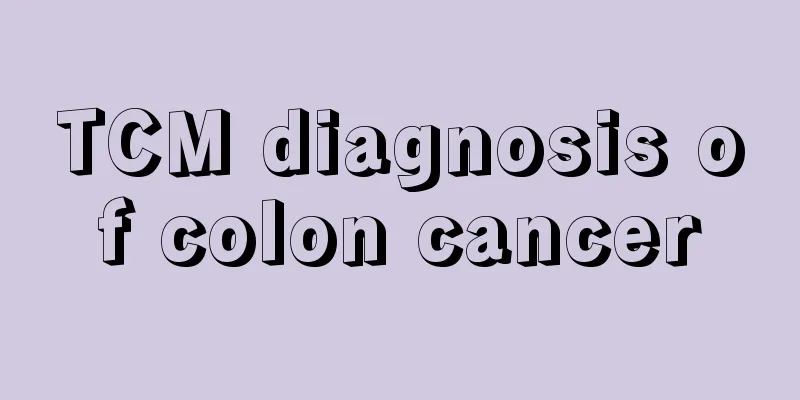TCM diagnosis of colon cancer

|
Colon cancer is a common malignant tumor in the gastrointestinal tract. The highest incidence rate is in the middle-aged group. The cause is not yet very clear, but some diseases such as familial polyposis have been recognized as precancerous lesions; colon adenoma, ulcerative colitis and colon schistosomiasis are closely related to the occurrence of colon cancer. The clinical manifestations of colon cancer vary with the size, location and pathological type of the lesion. Early stage colon cancer patients may have no clinical symptoms, but as the disease progresses and the lesions continue to grow, they may develop a series of common symptoms of colon cancer, such as increased frequency of bowel movements, blood and mucus in the stool, abdominal pain, diarrhea or constipation, intestinal obstruction, general fatigue, weight loss, anemia, etc. The entire colon is divided into two parts, the right colon and the left colon, with the middle of the transverse colon as the boundary. The clinical manifestations of these two parts of cancer do have their own characteristics, which are described as follows: Right colon cancer: The right colon cavity is thick, and the stool in the intestine is liquid. The cancer in this section of the intestine is mostly ulcerous or cauliflower-shaped cancer that protrudes into the intestinal cavity. There is rarely annular stenosis, so obstruction does not often occur. However, these cancers often rupture and bleed, and secondary infection is accompanied by toxin absorption. Therefore, clinically, there may be abdominal pain, changes in size, abdominal mass, anemia, weight loss or cachexia. Abdominal pain. Most patients have abdominal discomfort or dull pain, which is intermittent at first and then becomes continuous. It is often located in the right lower abdomen, which is very similar to chronic appendicitis. If the tumor is located in the hepatic flexure and the stool is dry and hard, colic may also occur. It should be distinguished from chronic cholecystitis. Some patients have loss of appetite, fullness, belching, nausea and vomiting. Stool changes: early stage stool is thin, contains pus and blood, and the frequency of bowel movements increases, which is related to the formation of cancer ulcers. When the tumor size increases, it affects the passage of stool, and diarrhea and constipation may occur alternately. The amount of bleeding is small, and it is fully mixed with stool as the colon moves, which is not easy to see with the naked eye, but the occult blood test is often positive. More than half of patients will find abdominal masses when they seek medical treatment. This mass may be the cancer itself, or it may be a mass formed by extraintestinal infiltration and adhesion. The former has a regular shape and clear outlines; the latter has an irregular shape. The mass is generally hard in texture, and once secondary infection occurs, it is limited in movement and tender. Anemia and cachexia. A small number of patients develop anemia due to continuous bleeding from cancer rupture, and may also experience weight loss, limb weakness, and even systemic cachexia. Abdominal colic is the main manifestation of intestinal obstruction associated with cancer. Obstruction may occur suddenly, with abdominal colic, accompanied by abdominal distension, hyperperistalsis, constipation and obstructed flatulence. Chronic obstruction may manifest as abdominal distension, paroxysmal abdominal pain, hyperactive bowel sounds, constipation, blood and mucus in stool. Partial intestinal obstruction sometimes lasts for several months before turning into complete intestinal obstruction. |
<<: What are the diagnostic criteria for colon cancer?
>>: Five major diagnostic tests for colon cancer
Recommend
Total laryngectomy for laryngeal cancer
Total laryngectomy is suitable for laryngeal canc...
How to treat advanced lung cancer? Introduction to the most effective treatment for lung cancer
In the early stage of lung cancer, there are usua...
Causes of premature birth
We call delivery between 28 and 37 weeks of pregn...
Is the smell of nail polish toxic
Nowadays girls like manicures and will apply nail...
The harm of hair dyeing for middle-aged and elderly people
As middle-aged people age, their hair often turns...
What are the effects of Bamboo Leaf Bupleurum
I believe that everyone does not have a clear und...
What should I do if I accidentally swallow detergent
Dishwashing liquid is a common daily necessity, a...
Knowing the diagnosis of colon cancer can help patients discover the disease earlier
Colon cancer is one of the most common tumor dise...
What are the magical uses of moxa sticks
Moxa sticks are a common Chinese herbal medicine ...
How to self-detect whether you have breast cancer? Teach you 4 self-detection methods for breast cancer
Breasts are the unique curves and charm of women....
How much does radiotherapy for breast cancer cost?
The cost of radiotherapy varies greatly in differ...
Analysis of the main advantages of TCM in treating pancreatic cancer
Pancreatic cancer is a very serious malignant tum...
What are the tips for putting the wine cork back in?
Some people cannot finish the wine immediately af...
What are the symptoms of nasopharyngeal carcinoma metastases to the brain?
Nasopharyngeal carcinoma is gradually understood ...
What are the dietary taboos for lung cancer patients? 4 dietary taboos for lung cancer
Since coughing and sputum are common symptoms of ...









